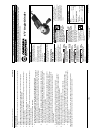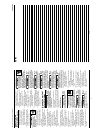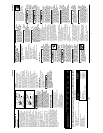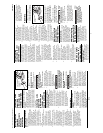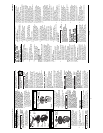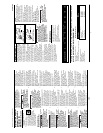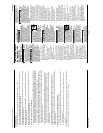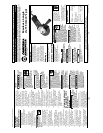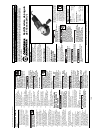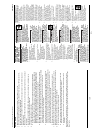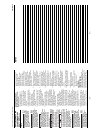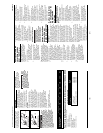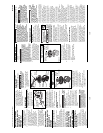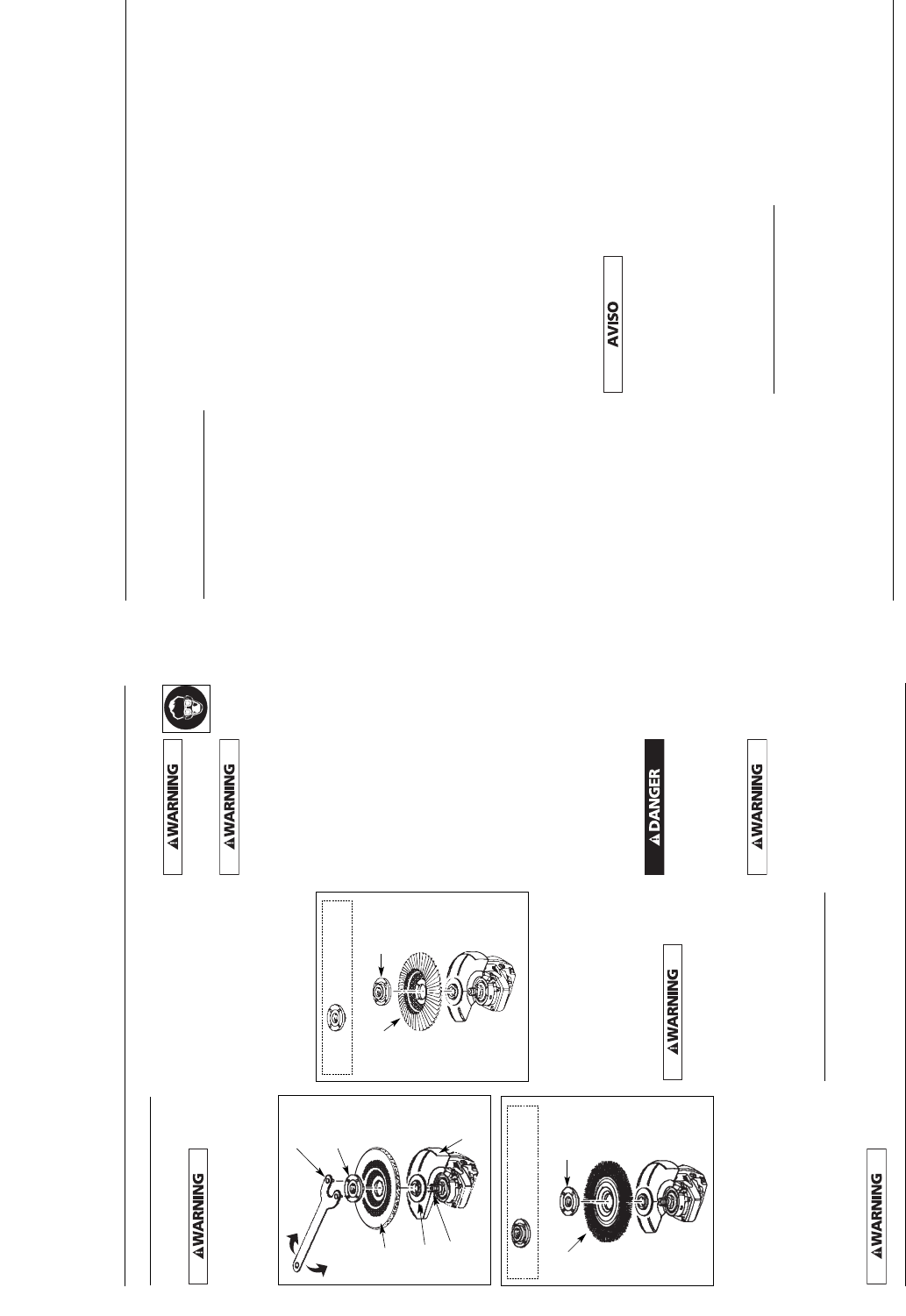
Información General
de Seguridad sobre
Herramientas
Eléctricas (Continuación)
13.Cuide sus herramientas.
14.Sostenga siempre la rectificadora
de modo seguro con las dos manos
mientras trabaja y en todo
momento mientras está en
funcionamiento.
15.Nunca cubra los orificios de
ventilación de la caja del motor con
las manos mientras hace funcionar
la rectificadora.
16.Mantenga la herramienta alejada
de su cuerpo mientras está en
funcionamiento. Mantenga las
manos lejos de los accesorios.
PRECAUCIONES: LIJADO
DE PINTURA
NO SE RECOMIENDA lijar pintura a base
de plomo ya que es difícil controlar el
polvo contaminado. El mayor riesgo de
envenenamiento con plomo lo tienen
los niños y las mujeres embarazadas.
Debido a la dificultad para identificar si
una pintura contiene plomo o no sin un
análisis químico, recomendamos las
siguientes precauciones cuando lije
cualquier pintura:
A. SEGURIDAD PERSONAL
1. Ningún niño ni ninguna mujer
embarazada deberán ingresar
al área de trabajo mientras se lija
pintura ni hasta que no se haya
terminado de limpiar.
2. Todas las personas que ingresen al
área de trabajo deberán usar una
máscara o respirador para polvo.
El filtro deberá reemplazarse a
diario o cuando el usuario tenga
dificultad para respirar.
Nota: se deberán usar únicamente
las máscaras para polvo aptas para
trabajar con polvo y humos de pintura
de plomo. Las máscaras para pintura
normales no proporcionan esta
protección. Consulte al proveedor de
su ferretería local para que le indique
la máscara (aprobada por NIOSH)
adecuada.
3. NO deberá COMER, BEBER ni
FUMAR en el área de trabajo para
evitar ingerir partículas de pintura
contaminadas. Los trabajadores
deberán lavarse y limpiarse ANTES
de comer, beber o fumar. Los
artículos de comida, bebida o para
fumar no deberán dejarse en el
área de trabajo donde el polvo
pueda asentarse.
B. SEGURIDAD AMBIENTAL
1. La pintura se deberá quitar de un
modo que minimice la cantidad de
polvo que se genere.
2. Las áreas donde se esté quitando
la pintura deben sellarse con
coberturas plásticas de 4 mils de
grosor.
3. El lijado se debe realizar de un
modo que reduzca el traslado del
polvo de pintura fuera del área de
trabajo.
C. LIMPIEZA Y DESECHO
1. Todas las superficies del área de
trabajo deben aspirarse y limpiarse
por completo a diario durante el
proyecto de lijado. Las bolsas de
filtro de la aspiradora deben
cambiarse con frecuencia.
2. Los paños cobertores de plástico
deben juntarse y desecharse con
todos los restos de polvo y demás
residuos. Deben colocarse en
receptáculos sellados para basura
y desecharse mediante los
procedimientos de recolección
de basura normales. Durante la
limpieza, los niños y las mujeres
embarazadas deben mantenerse
alejados del área inmediata de
trabajo.
3. Todos los juguetes, muebles
lavables y utensilios que usen los
niños deben lavarse muy bien antes
de volver a usarlos.
MANTENIMIENTO
Haga
que sólo
personal calificado preste
mantenimiento a su herramienta
eléctrica y usando sólo repuestos
idénticos. Esto asegura que se preserva
la seguridad de la herramienta
eléctrica.
Instrucciones de
Seguridad
Adicionales para
Todos los Trabajos
Contragolpe y Advertencias
Relacionadas
El contragolpe es la reacción improvisa
de una rueda, almohadilla de soporte,
cepillo o cualquier otro accesorio en
rotación que haya quedado atrapado o
atascado. El quedar atrapado o
atascado causa una parada improvisa
del accesorio en rotación que, a su vez,
causa que la herramienta eléctrica
venga forzada fuera de control en la
dirección opuesta al sentido de
rotación del accesorio en el punto
donde quedó atascado.
Por ejemplo, si una rueda abrasiva
queda atrapada o atascada por la pieza
de trabajo, el borde de la rueda que
está ingresando en el punto donde se
atasca puede hundirse en la superficie
del material provocando que la rueda
se zafe o salte hacia afuera. La rueda
puede saltar hacia el operador o
alejarse de él, según la dirección del
movimiento de la rueda en el punto
donde ha quedado atascada. Las
ruedas abrasivas bajo estas condiciones
pueden también quebrarse.
El contragolpe es el resultado de un
mal uso de la herramienta eléctrica y/o
de procedimientos o condiciones de
funcionamiento incorrectos y puede
evitarse tomando las precauciones
necesarias que se proporcionan a
continuación.
1. Sostenga la herramienta eléctrica
con firmeza y posicione su cuerpo y
brazo de un modo que le permita
resistir las fuerzas del contragolpe.
Use siempre el mango auxiliar, si se
proporciona, para el máximo
control del contragolpe o reacción a
la torsión durante el arranque. El
operador puede controlar las
fuerzas de reacción a la torsión o
contragolpe si toma las
precauciones necesarias.
2. Nunca ponga las manos cerca del
accesorio en rotación. El accesorio
puede dar un contragolpe contra su
mano.
3. No posicione su cuerpo en el área
donde la herramienta eléctrica
podría desplazarse si se produjera
un contragolpe. El contragolpe
desplaza la herramienta en
dirección opuesta al movimiento de
la rueda en el punto donde ha
quedado atascada.
4. Ponga especial atención cuando
trabaja con ángulos, bordes filosos,
etc. Evite que el accesorio rebote o
quede apretado. Los ángulos, los
bordes filosos y los rebotes tienden
a apretar el accesorio en rotación y
causan pérdida de control o el
contragolpe.
5. No monte una hoja de esculpir
madera de una sierra de cadena o
una hoja de sierra dentada. Esas
hojas causan frecuentes
contragolpes y pérdidas de control.
23 Sp
DG470500CK
6
www.chpower.com
Operating Instructions and Parts Manual
Assembly (Cont.)
INSTALLING ACCESSORY WHEELS
1. UNPLUG YOUR GRINDER.
Failure to
unplug
your grinder could result in accidental
starting causing serious injury.
2. Your grinder is shipped with the
disc flange and clamp nut attached
to the spindle (see Figures 2 & 3) .
3. Depress spindle lock button and
rotate clamp nut until spindle locks
(see Figure 1). To prevent damage
to the spindle or spindle lock,
always allow motor to come to a
complete stop before engaging
spindle lock.
4. Loosen and remove clamp nut from
spindle. DO NOT remove disc
flange.
5. Place the accessory wheel over the
spindle.
Always
install
grinding wheel and abrasive mop disc
with the depressed center against the
disc flange as shown above. Failure to
do so will cause the grinding wheel to
crack when tightening the clamp nut.
This could result in serious personal
injury because of loose particles
breaking off and being thrown from
the grinder. Do not overtighten.
6. To install grinding wheel and wire
wheel brush: Thread the clamp nut
on the spindle with the flat side of
nut facing up. Fit raised, small
diameter portion of the clamp nut
into the hole in the wheel and
finger tighten.
7. To install abrasive mop disc: Thread
the clamp nut on the spindle with
the flat side of nut facing down.
Finger tighten (see Figure 4).
8. Depress the spindle lock button and
rotate the wheel clockwise until the
spindle locks in position.
9. Securely tighten the clamp nut with
the wrench provided. Do not
overtighten.
Wire
wheel
brush bristles will bend during use and
show their direction of rotation. When
reusing the wire wheel brush, always
mount it to rotate in the same
direction as in prior use. Failure to
heed this warning can result in bristle
breaking and extreme vibration of the
wire wheel brush that could result in
serious personal injury.
Operation
POWER SWITCH
The power switch will “lock” into the ON
position by pushing the switch
completely forward and then pushing
the forward part of the switch down. To
turn the tool OFF, push down on the rear
portion of the power switch.
Safety glasses mustbe worn
during operation.
Make
sure
work is held securely in vise or
clamped in place prior to starting
operation. Loose work may spin and
cause bodily injury.
Be certain wheel guard and auxiliary
handle are installed. Firmly grip the
auxiliary handle and motor housing.
Lift up rear of motor housing so that
only the front section of grinding
wheel contacts the work. Use light
pressure. Always lift the grinder off
work before starting or stopping
motor. The arrow on the front gear
housing indicates the direction in
which the grinding wheel rotates. The
arrow resembles the number 1.
GRINDING, SANDING, BRUSHING
Always carefully select and use
grinding wheels that are
recommended for the material to be
ground. Make sure that the minimum
operating speed of any accessory
wheel selected is not less than 11,000
RPM.
The grinding wheel provided with your
grinder is suitable for grinding welds,
preparing surfaces to be welded,
grinding structural steel, and grinding
stainless steel. The wire wheel brush is
suitable for removing paint or rust
from metal surfaces. The abrasive mop
disc is suitable for sanding flat metal or
wood surfaces.
Never use
your
grinder with the guard removed. This
tool has been designed for use ONLY
with the guard installed. Attempting to
use grinder with guard removed will
result in loose particles being thrown
against the operator resulting in
serious personal injury.
Inspect
wire
wheel brush before each use. Never
use one that is rusted, damaged or not
marked for a minimum speed of 11,000
RPM or higher. Failure to heed this
warning can result in serious personal
injury.
The key to efficient operation begins
by controlling the pressure and surface
contact between the grinding wheel
and workpiece. Flat surfaces are
ground at an acute angle, normally
Clamp nut
turned incorrectly
Abrasive
mop disc
Clamp nut
turned
correctly
Clamp nut
turned incorrectly
Wire
wheel
Clamp nut
turned
correctly
Figure 3
Figure 4
Grinding
wheel
Disc
Flange
Clamp
Nut
Spindle
Wrench
To
Tighten
To
Loosen
Guard
Figure 2



